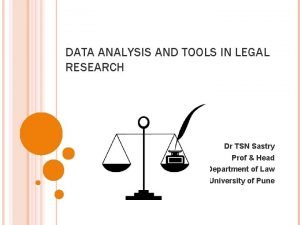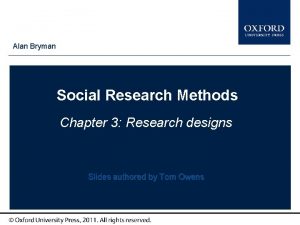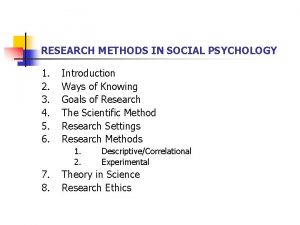GCSE Sociology Research Methods Secondary Data Secondary Data












- Slides: 12

GCSE Sociology Research Methods Secondary Data

Secondary Data Secondary data is information that already exists

Strengths and Weaknesses of Secondary Data 1. The material is readily available and so is cheap and easy to use 4. Less time consuming than primary research 6. They may be the only available source of information, for example in studying the past. 5. Some documents might be difficult to access 3. The information may be forged, biased or contain errors 2. The information may be unrepresentative

Secondary Data: Official Crime Statistics Official crime statistics refer to those crimes that are recorded by the police. Produced annually by the Home office Reveal crime rates and police effectiveness

Official Crime Statistics: Exploring the validity of crime statistics The use of official crime statistics highlights some of the potential problems in using secondary data in sociological research

Why might someone not report a crime to the police? The public may not report all crimes to the police: they may not realise they’ve been a victim they may see it as a private matter/ embarrassment they may implicate themselves in a criminal act.

Dark-figure of crime… Is all crime reported and recorded? ? http: //www. youtube. com/watch? v=jzd. Ti. M 5 w. S_c

What types of crime are less likely to be reported to the police and why? Trivial, e. g. dent in car door Victim suffered no loss Work place crime …. employers often deal with it themselves rather than involve the police – this may account for the amount of white collar crime such as fraud/theft in the work place being under reported Serious assault, domestic violence, child abuse

According to the British Crime Survey, only one in three victims of domestic violence report the incident to the police. Reasons for non-reporting include a desire for privacy , fear of reprisals and of family break up.

Other ways of measuring crime – Victim surveys and Self-Report Studies Victim studies – the most famous of which have been the British Crime Surveys carried out by the Home Office – aim to identify the extent to which a representative sample of people have been victims of crimes. Self-Report studies in contrast, aim to investigate the characteristics of offenders by getting a sample group to reveal details of offences committed.

Validity vs Reliability

Reliability means the research could be repeated – e. g. questionnaires and structured interviews Validity means whether the research has uncovered the truth of social life – e. g. participant observation and unstructured interviews
 Primary and secondary data
Primary and secondary data Methods of promotion gcse business
Methods of promotion gcse business Importance of data in legal research
Importance of data in legal research Indirect methods of contoring uses how many methods
Indirect methods of contoring uses how many methods What is field research in sociology
What is field research in sociology Primary data
Primary data Research design example
Research design example Exploratory research secondary data
Exploratory research secondary data Secondary data are
Secondary data are Gcse business studies market research
Gcse business studies market research Alan bryman social research methods
Alan bryman social research methods Research method notes
Research method notes Research methods in social psychology
Research methods in social psychology























